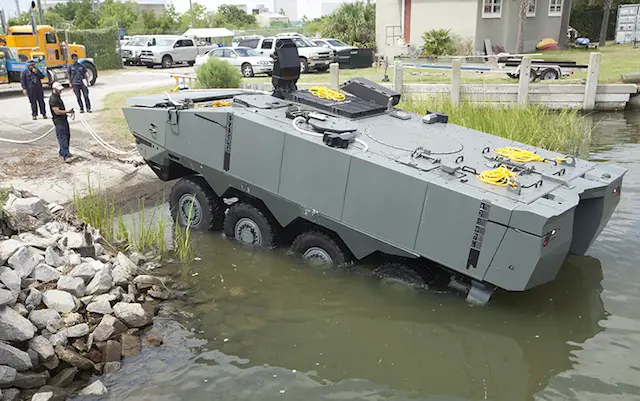Breaking news
SAIC and BAE Systems win USMC’s amphibious combat vehicle competition 42511151.
|
|
|||
|
Defence & Security News - (USA)
|
|||
|
|
|||
| SAIC and BAE Systems win USMC’s amphibious combat vehicle competition | |||
|
SAIC and BAE Systems have been selected by the United States Marine Corps in the elimination phase of the Amphibious Combat Vehicle programme. The two companies will build the prototype vehicles of the project, which will replace the AAV7 vehicles currently in use. Thus, the Marines will have a modern wheeled vehicle that will move them from ship, to shore and then towards the inland.
|
|||
|
|
|||
 SAIC teamed with ST Kinetics to offer the TERREX 2 vehicle (above) and BAE Systems with IVECO offering the SuperAV (below). (Photo: SAIC, BAE Systems)
|
|||
|
|
|||
|
BAE Systems received a contract of USD103.8 million and SAIC of USD121.5 million. Each of the two companies will have to build 13 prototype vehicles, which would increase to 16 after an option is exercised and once the USMC will have funding available. The prototype platforms will have to be delivered between January and April of 2016. The Corps has decided to have such a significant number of prototypes being built in order to speed up the testing, by allowing to run simultaneously the necessary activities and the tactics that will be developed to verify their capabilities, helping the Marines to familiarize themselves with the new platforms. By the end of 2017 or early 2018, upon the completion of the testing phase, the experience gained from the operation of the vehicles will be used to refine the requirements of the final version of the ACV or ACV 1.2 as it has been named. That is when the USMC will award the winner for the single-source contract of 204 ACV 1.1 version vehicles, with a projected unit cost of around USD7 million and first entry in service in 2021. When production of the ACV 1.1 – troop carrying variant - is complete, the USMC will move forward with the ACV 1.2, in 490 units, which will feature additional versions with more sensors and possibly heavy weapons. This procurement strategy was due to the Corp’s need for reduced development risks, making it easier to move to the new versions once the basic configuration would be secured. The roots of this concern are found in USMC’s past decision to cancel the inshore Marine Personnel Carrier (MPC) programme and start the ACV, which took off-the-shelf wheeled platforms and turned them into amphibious ones. As the ACV 1.1 will prove its capability to transport troops and equipment from ship to shore, those initial specifications will weigh lower in ACV 1.2’s.
The two companies have partnered with foreign manufacturers, offering proven, off-the-shelf solutions. BAE Systems has teamed with the Italian IVECO, offering a version of the SuperAV 8x8 vehicle, while SAIC joined forces with the Singaporean ST Kinetics to offer the TERREX 2. The new vehicles will have to travel at 65 mph, in order for the motherships to stay as far as possible from the enemy coast, albeit modern coastal missile defence systems can easily reach at those distances. Both vehicles can travel at a speed of around 7 mph in water, carrying 11 Marines. The overall programme is an effort to balance between many different technical characteristics. That is a balance between speeds at sea and on land, size and transport capability, and room for future upgrades in its equipment with changes in its weight. However, the USMC has opted for a rather limited speed at sea, as opposed to that of a water-skiing platform, considering that the bulk of the operations would take place inland where maneuverability is of paramount importance. The reduced speed at sea, which according to some makes the vehicles easy targets for the enemy defence, could be balanced by the support provided by other elements of the Marine Air-Ground Task Force, according to military officials. |
|||




















